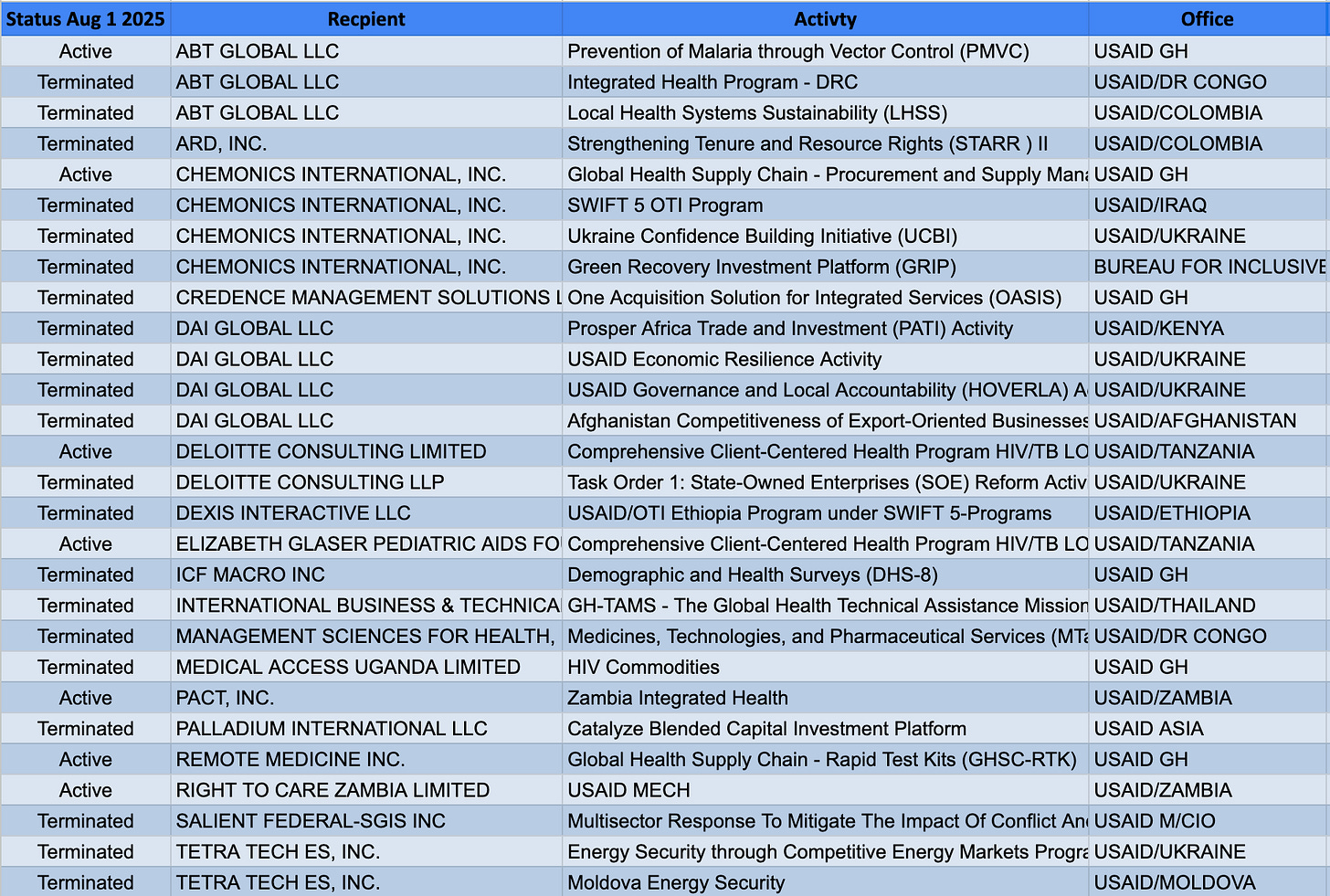We Analyzed Every USAID & State Department Contract—Here's What Remains
Which USAID and State Department Grants or Contracts survive? Our best estimates are not pretty.
USAID is pretty much dissolved and the State Department is in disarray. Yet we all what to know the answer to a very important question:
Is my project permanently terminated? Which programs survived?
We researched every submission to Congress, every publication by DOGE, and applied our decades of contracting experience to build the most accurate list of what we believe is active, terminated, and likely ended across all USAID and State Department contracts and grants.
We know that this spreadsheet isn’t 100% accurate. What did we miss?
We don’t believe anyone actually has a completely accurate list - especially not the remaining USAID or State staff. They are probably too overwhelmed by internal chaos to even understand the full scope of what's happening to humanitarian funding right now.
We do believe that USG foreign assistance funding is worse than most people realize. Out of 11,004 contracts and grants at USAID and State Department that we can track, only 3,052 remain active as of August 1, 2025. That's just 28%.
Nearly three-quarters of humanitarian funding is gone.
The 72% termination rate represents a significant pattern that demands attention regardless of what new funding might exist elsewhere.
A Numeric Brutal Reality
This analysis reflects contract and grant status as tracked through August 1, 2025. The dataset may not capture newly awarded contracts that replaced terminated ones, or funding that has shifted to different tracking systems.
Active Funding That Remains:
USAID: 828 active contracts/grants (13% survival rate)
State Department: 2,224 active contracts/grants (47% survival rate)
Total Active: 3,052 out of 11,004 original awards
What's Already Gone:
USAID Ended: 5,405 contracts/grants terminated
State Department Ended: 2,547 contracts/grants terminated
Total Ended: 7,952 funding streams eliminated
The State Department is maintaining nearly half its funding portfolio, while USAID has seen 87% of its contracts and grants end. Whether this represents policy decisions, natural contract cycles, or funding reallocation isn't clear from the data alone—but the pattern suggests structural changes beyond normal operations.
Funding Has Fundamentally Changed
Organizations that built their operations around multi-year USAID funding streams are discovering those pipelines have dried up.
The 13% survival rate for USAID contracts & grants tells the story: if you had USAID funding, there's an 87% chance it's gone. However, if you have one of the 828 remaining awards, the average contract size is $208.5 million.
State Department funding shows more resilience, with nearly half still active (167 contracts and 2,057 grants). But even here, the average contract size of $7.6 million suggests smaller, more targeted funding rather than the comprehensive program support many organizations need.
What the Trends Reveal
State Department funding is outlasting USAID funding by nearly 4:1.
This shift represents a fundamental change in how the U.S. approaches international assistance.
State Department funding traditionally focuses on diplomatic priorities, shorter-term interventions, and crisis response. USAID funding historically supported longer-term development work, capacity building, and systematic change efforts.
The survival rates suggest a move away from comprehensive development approaches toward more immediate, diplomatically-aligned interventions.
The infrastructure that supported thousands of humanitarian organizations has been largely dismantled. Supply chains, partnership networks, and institutional knowledge built around specific funding streams have been disrupted.
Looking Forward
The data shows State Department funding has better survival rates than USAID funding. But we need to be clear about what this means.
The humanitarian sector as we knew it has fundamentally changed.
The organizations and approaches that survive will be different from those that built the sector over the past decades. Whether that change serves humanitarian needs better or worse remains to be seen.
Your sadness about ended contracts and grants is a rational response to documented systematic change. The numbers confirm what humanitarian workers are experiencing: most of the funding infrastructure they depended on has disappeared.
The question now becomes: what do we build in its place?




their is three more years of cutting coming?